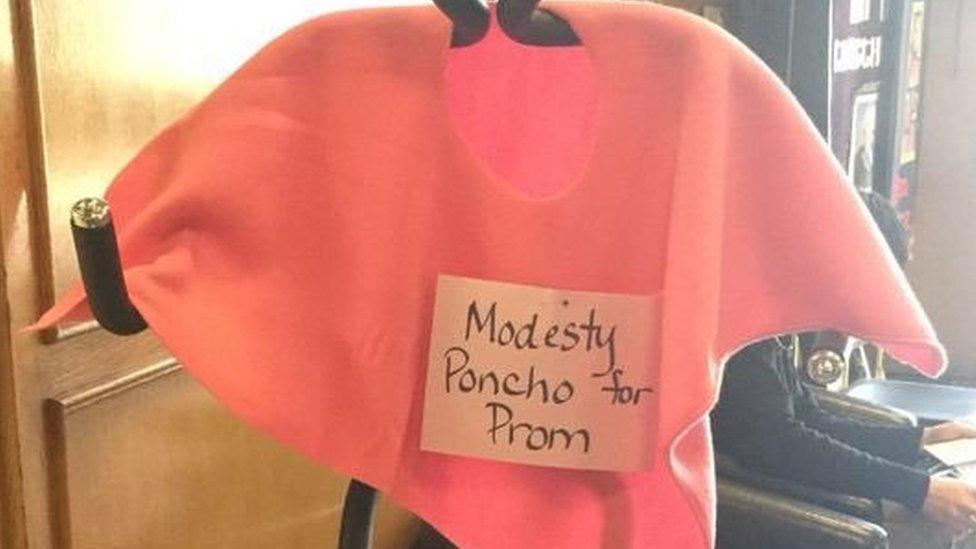Backlash over plan to give out 'modesty ponchos' at prom
- Published

A school in Michigan has been criticised over threats to make students wear a "modesty poncho" if they fail to adhere to a strict dress code for their prom.
People on social media have supported students who posted photos of the ponchos, saying the policy highlighted society's double standards towards men and women.
The dress code, external for the dance includes requirements such as "no exposed cleavage", "no backless dresses" and "hemlines no shorter than one inch above the knee joint".
Students were told they might be sent home if they flouted the dress rules but the problem came to a head when "modesty ponchos" were put on display around the Divine Child High School in Dearborn.
A note attached to the poncho read: "If your dress does not meet our formal dress requirements - no problem! We've got you covered - literally. This is our modesty poncho which you'll be given at the door."
As a result of complaints a letter has since been sent to parents stressing that the additional garments will not be handed out on the night.
Allow X content?
This article contains content provided by X. We ask for your permission before anything is loaded, as they may be using cookies and other technologies. You may want to read X’s cookie policy, external and privacy policy, external before accepting. To view this content choose ‘accept and continue’.
Eric Haley, principal of the Catholic school, wrote: "Our intention with displaying the poncho was never to make students feel uncomfortable but to remind all students of our formal prom dress policy which has not changed for several years."
The teacher behind the "ponchogate" uproar, Mary O'Malley, told Fox 2, external: "We are trying to focus on the inner beauty of people and not draw attention to something that doesn't need to have attention drawn to it.
"It was really intended as a deterrent and a really light-hearted one at that."
You might also like:
In online debate, there were calls for students to be allowed to just wear what they wanted to the prom.
Allow X content?
This article contains content provided by X. We ask for your permission before anything is loaded, as they may be using cookies and other technologies. You may want to read X’s cookie policy, external and privacy policy, external before accepting. To view this content choose ‘accept and continue’.
Cam I, external said: "Prom is supposed to be an event away from school so why have a dress code besides don't show up naked?"
Others complained about what they felt was inherent sexism in prom dress codes.
Molly Ledford, external said she thought that dress restrictions were always harsher on girls than boys.
Allow X content?
This article contains content provided by X. We ask for your permission before anything is loaded, as they may be using cookies and other technologies. You may want to read X’s cookie policy, external and privacy policy, external before accepting. To view this content choose ‘accept and continue’.
And Alexa, external added: "Not once in my life have I seen a boy get dress coded. The dress code was created by men who were once the creepy little boys they made it for.
"Heaven forbid people know I have a chest or worse shoulders."
Divine Child High School's prom dress code for male students includes a requirement to be clean-shaven and, unlike female students, they cannot wear earrings.
'My jeans had rips in them'
For some, the "modesty poncho" story has brought back memories of when their choice of dress was questioned at school.
Allow X content?
This article contains content provided by X. We ask for your permission before anything is loaded, as they may be using cookies and other technologies. You may want to read X’s cookie policy, external and privacy policy, external before accepting. To view this content choose ‘accept and continue’.
But there has been humour too.
Allow X content?
This article contains content provided by X. We ask for your permission before anything is loaded, as they may be using cookies and other technologies. You may want to read X’s cookie policy, external and privacy policy, external before accepting. To view this content choose ‘accept and continue’.
Allow X content?
This article contains content provided by X. We ask for your permission before anything is loaded, as they may be using cookies and other technologies. You may want to read X’s cookie policy, external and privacy policy, external before accepting. To view this content choose ‘accept and continue’.
- Published1 May 2018

- Published4 April 2018

- Published11 April 2018
